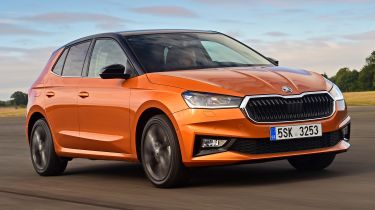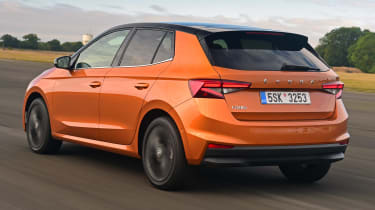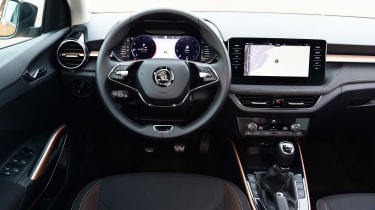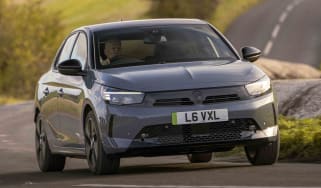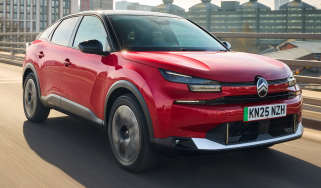New Skoda Fabia 2021 review
The new Skoda Fabia has all the credentials to challenge the very best in the supermini class

Verdict
It looks like Skoda is onto another winner with the Skoda Fabia. It’s among the most spacious superminis in the segment, has some great tech within a well-finished cabin, and proves to be comfortable and - minor question marks over road noise aside - refined, too. It looks like a real, credible threat to our current favorite supermini, the Renault Clio.
The Skoda Fabia has become a byword for an affordable, practical supermini. If you’re a small-car buyer that has a head-over-heart philosophy, it’s a model that has long since earned its place right towards the top of your shortlist. And many people clearly are that type of buyer; the Czech brand has shifted 4.5 million Fabias since the first model made its debut back in 1999.
More than two decades down the line, we’ve reached the fourth-generation model. From our first encounter with the car, it shows that in one or two areas, it might have just upped the desirability stakes too. And we’re not just talking about the love-or-loathe Phoenix Orange paint job (we’re very much in the former camp).
Under the skin, there are significant changes relative to the old model, though few come as a big surprise. The fourth-gen Fabia finally sees the model move onto the Volkswagen Group MQB-A0 platform that has been used by the VW Polo and the SEAT Ibiza for a couple of years.
Used - available now

2014 Skoda
Fabia
118,000 milesManualDiesel1.6L
Cash £3,500
2019 Skoda
Fabia
25,704 milesManualPetrol1.0L
Cash £8,563
2021 Skoda
Fabia
30,022 milesManualPetrol1.0L
Cash £10,187
2020 Skoda
Fabia
29,557 milesManualPetrol1.0L
Cash £9,049MQB-A0 brings plenty of benefits over the old PQ26 platform. It’s not just more rigid than the old car - improving refinement, road holding and safety - but it’s also lighter. As a result, even though the new model is 111mm longer than its predecessor, it weighs roughly the same.
That extra length translates well to the Fabia’s cabin, because it feels spacious compared with the outgoing car, and most superminis in general. Keeroom is excellent for a car of this size - not quite as roomy as mainstream hatchbacks from the segment above, but on a par with premium models like the Mercedes A-Class. Headroom is absolutely fine, too, even when equipped with the huge panoramic glass roof of our test car. At 380 litres, the boot is among the best in the segment; little other than the Renault Clio’s 391 litres tops this. It’s also identical to what you’ll get from a Volkswagen Golf. In fact, it’s so spacious inside that you might begin to question why you’ll need to bother stretching the budget towards a conventional family hatchback.
The same goes for the quality. Skoda’s recent releases, the Octavia and fully electric Enyaq included, feel a cut above the equivalent VW products inside - and the Fabia is no different. The understated yet logical layout looks neat and is finished with fairly high quality materials; the fabric trim across the dash feels like a smart touch.
It’s not quite on a level of the current poshest option in the segment, the Peugeot 208, but it’s able to compete with the Renault Clio, and feels more fancy than the Polo. It does appear that the budget for the best materials had run out by the time the trimmers reached the back though; the rear door cards are moulded from a piece of hard, scratchy plastic.
The infotainment set-up is the latest generation of the VW Group’s tech. That is to say, it looks great and the graphics are sharp, but it’s perhaps not quite as quick to load and respond as some rival systems. Higher-spec models now come with a 10-inch Virtual Cockpit digital driver’s display. It’s the best of its type in the segment, offering plenty of different screen layouts and easy-to-read information.
The engine line-up is petrol only, and UK buyers are offered a 1.0-litre unit in a choice of four power outputs. The two least potent do without a turbo to pump out 64bhp and 84bhp, while forced induction raises the outputs to 94bhp and the top-end 108bhp option that’s driven here. Next year, a larger 1.5-litre turbo will also join the range; this will offer 148bhp and a sub-eight second 0-62mph time. At this stage there’s no hybridisation of the Fabia, and unlike with rivals like the 208 and Vauxhall Corsa, no diesel or fully electric options, either.
The engine is a smooth, relaxing unit, and, returning nearly 55mpg on a motorway cruise, proved to be very frugal, too. The three-cylinder unit might be small, but it only really makes its presence felt under hard acceleration; otherwise it’s very subdued. In fact, at higher cruising speeds it’s drowned out by road noise - partly because the engine is so quiet and partly because there’s a little more road rumble than we’d like.
That aside, it’s impressively comfortable by supermini standards. The ride is towards the softer end of the segment, and paired with the 16-inch alloy wheels on our test car, it delivers a relaxing drive. As with previous Fabias, sharp handling isn’t really on the agenda, so you get numb steering and a neutral balance. If fun is your main priority from a supermini, then look at a Ford Fiesta or a Mazda 2. Otherwise, the Fabia is absolutely fine.
It’s also genuinely tempting value. Prices for the Skoda Fabia kick off from £14,905 for the entry-level S trim, and even here there are big ticket features included right at the entry point in the range. LED headlights, auto emergency braking and a lane-keep assist system are standard, while creature comforts inside include a 6.5-inch infotainment system and air conditioning.
Above that sits the SE Comfort, which starts from £16,795. Among its extras, it gains 15-inch alloy wheels, front fog lights, rear parking sensors and height adjustment for the front seats. The Colour Edition model is the next step up, gaining cosmetic tweaks like black 16-inch wheels and privacy glass, plus a 10-inch Virtual Cockpit display and keyless start.
The SE L (which this Czech-spec Fabia most closely aligns with) steps things up further with 16-inch wheels, electric windows all round, and the larger 9.2-inch infotainment display. With the 108bhp 1.0 TSI and a manual gearbox, it costs £19,330; that’s just £230 more than a Renault Clio S Edition petrol that has to settle for 29bhp less. And when it comes to value, it’s not like the Clio isn’t a strong proposition itself.
| Model: | Skoda Fabia SE L 1.0 TSI |
| Price: | £19,330 |
| Engine: | 1.0-litre 3cyl turbo petrol |
| Power: | 108bhp/200Nm |
| Transmission: | Six-speed manual, front-wheel drive |
| 0-62mph: | 10.0 seconds |
| Top speed: | 127 mph |
| Economy/CO2: | 50.4mpg/128g/km |
| On sale: | Now |

